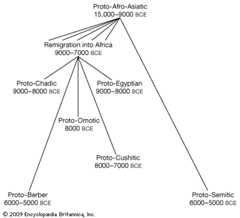Egyptian language
Our editors will review what you’ve submitted and determine whether to revise the article.
Egyptian language, extinctlanguage of the Nile valley thatconstitutes a branch of theAfro-Asiatic language phylum. TheSemitic,Cushitic,Chadic,Omotic, andAmazigh (Berber) language groupsconstitute the remaining members of the phylum.
On the basis of ancient texts, scholars generally divide the history of Egyptian language into five periods: Old Egyptian (from before 3000 to about 2200bce), Middle Egyptian (c. 2200–c. 1600bce), Late Egyptian (c. 1550–c. 700bce), Demotic (c. 700bce–c. 400ce), andCoptic (c. 2nd centuryce until at least the 17th century). Thus, five literarydialects aredifferentiated. These language periods refer to the written language only, which often differed greatly from the spokendialects. Coptic is still inecclesiastical use (along withArabic) among the Arabic-speakingmiaphysite Christians of Egypt.
Phonology
Thephonetic values of theconsonants have not all been established with certainty. The emphatics*ṭ and*ṣ (an asterisk indicates ahypothetical form derived from later attestations) seem to have merged with originally nonemphaticstops. Final*-r (at end of syllable) shifted to-ʾ (hamzah, a glottal stop);*li and*lu toʾi;*ki and*ku toṯ (pronounced astch); and*gi and*gu toḏ (pronounceddj).

In some casesṯ andḏ apparently reflect originalaffricates. Egyptiand andḏ (both possibly unvoiced) also correspond to Afro-Asiatic emphatics and were so transcribed inHebrew. Later,*ti and*tu, as well as*di and*du, seem to have been affricated and have variant writings withṯ andḏ. The originallateral sounds were lost. The values ofg andq are unclear but were transcribed as emphatics in Hebrew. Thesibilantss andš are straightforward.
Word formation, morphology, and syntax
Word formation in Egyptian is similar to the “root and pattern” system found across the Afro-Asiatic language phylum. In such systems, consonantal “roots” that indicate the general meaning of a word join with vocalic “patterns” that create more specific meaning. An example in English would be the difference between the wordswake andwoke, in which the rootSquare root of√wk provides a basic notion of “being awake” and combines with the patterns-a-e and-o-e to create verbs of a particular tense. In ancient Egyptian texts, roots were predominantly composed of three consonants, and vowels were omitted.
Of the original Afro-Asiatic verb system, only the stative survived. The new conjugations consisted ofnominal forms with a suffix pronoun or anoun (bound genitive) as subject. Suffixes indicated tense andvoice. Later these conjugations were replaced by adverbialpredicates (e.g., preposition plus infinitive).
Stem modifications were limited. Ans- causative stem corresponds to the Semitic causatives, but it was no longer productive by Late Egyptian. The pronouns are close to those of Semitic. Some nouns of place or instrument were formed with the prefixm-. The masculine singular noun had no ending or was*-aw, feminine singular*-at, masculine plural*-āw, and feminine plural*-āwāt.

Syntax was governed by a rigid word order, with modifiers occurring in second position. Genitival constructions are of two types in all phases of Egyptian: noun with reduced stress bound to the possessor or noun plus the genitivaladjectiven(y) ‘of’ followed by the possessor.
Writing
Thewriting system was both logographic andphonetic.Logographic signs represent words, andphonetic signs represent one to three consonants (vowels not being of concern). Phonetic signs are used without regard for their original meaning. Thus, because the logograph for ‘house’ also signifies the soundpr, it is used to write the wordprn ‘to go out.’ Because vowels are not represented in writing, the logograph forprn is differentiated from that forpr ‘house’ by the addition of the sign ‘walking legs.’ This type of addition is known as a “semantic determinative” because it indicates thepart of speech (and thus the meaning) of the word in question.
Several scripts were in use:hieroglyphic in monumental inscriptions and the cursivehieratic (and its later derivative,demotic) onpapyrus, potsherds, and stone flakes. Coptic has an alphabetic script based on theGreek alphabet, with several lettersderived from demotic signs. There is a considerable and varied literature in Egyptian. Coptic texts are mostly of a religious nature.
James HochThe Editors of Encyclopaedia Britannica






